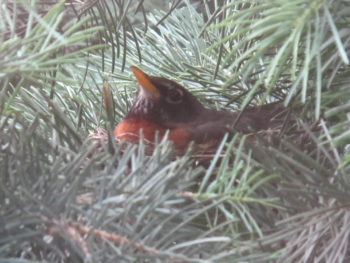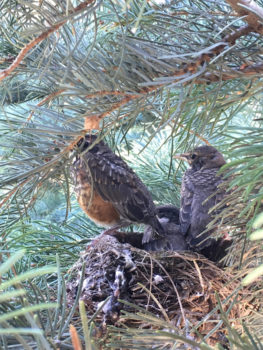At the end of June I noticed a robin standing on the rail of our deck, which caught my attention. I found it odd to see the robin standing there so calmly. As I watched it, it flew up and landed in a nest that was perfectly situated in the large blue spruce just outside the dining room window. I was thrilled to see this and it appeared the nest was specifically designed for viewing. Once I stood on a dining table chair, I had an ideal view of something I’d never witnessed – the birth of baby robins.

A robin lands on the rail of our deck and intrigues me.
First, for about two weeks, I watched the mother sit on the eggs in the nest. She took turns tending the nest with the father, a larger robin. The two parents would swap sitting duties. When I’d go out on the deck to attempt to take a better photo, either the mother or father robin would fly at me with a wild screech and I’d run back into the house. This is the reason most of my photos are fuzzy; they’ve been taken through the dining room window.

Close-up of mother robin on nest in tree.

This is the POV from the dining room window.
It took about two weeks for the eggs to hatch and I was unable to get a photo of the eggs. But imagine four beautiful blue robin eggs at the bottom of the nest. I would look at the robins and the nest many times during the day to see what would happen next. And then, finally, the baby birds hatched. They looked tiny and very tired and it was easy to see their four heads poking up.

Here’s a shot of the four babies snuggled into the nest, which was the perfect size for everyone. One baby droops its head along the outside of the nest.

Here is another photo of the babies.
The babies grew quickly and I was amazed at their progress. Closed eyes began to open and the critters found their chirping voices as the parents would bring them worms. The parent robins would fly off, only to return with a bounty. The baby birds would burst straight up and open their beaks seemingly starving for food. They continued to grow in this well-orchestrated process. One day it rained and the mother bird hunkered down and seemed to flatten out over her babies like a feathery umbrella.

The mother robin protects the four babies from the rain.
Day after day the feeding process took place. More and more feathers dried out and I wondered if everyone would have enough room in the seemingly crowded nest. But they always did. The four babies could also flatten down into the nest for protection.

The four babies are growing.
Sometimes one of the parents would head off to the spa for a needed break.

A nice getaway.
Standing on the side of the nest was the next major step and I noticed the largest baby robin did this. I would watch as the mother or father robin would fly off and land in a nearby tree, encouraging the babies to follow suit. Eventually, there was the first brave soul.

Standing on the edge of the nest and contemplating the universe of sky and trees.
Baby after baby flew off until there was just the smallest robin alone in the nest. I wondered if it had been abandoned. When I told a good friend about the last lonely one she wrote, “I think he’s the careful one and will live the longest.”

Alone but not forgotten.
And then, as nature would have it, everyone zoomed away. All that was left was the well-made, well-placed nest. Perhaps we’ll look for round two.

Empty now, but we’ll see what happens.
